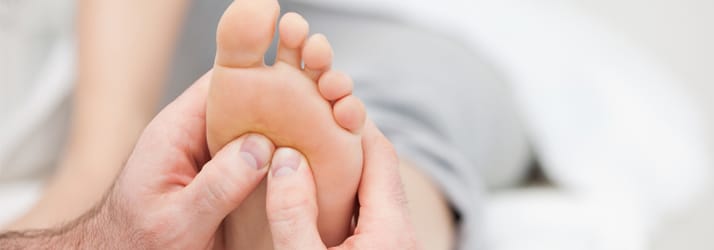The Modern Shoe Debate: Barefoot vs Conventional Shoes
The Modern Shoe Debate: Barefoot vs Conventional Shoes
By Dr. Frank A. Lee DC, CCEP

With the vast advancement of information and technology, a question often arises regarding modern-day things, are they truly more superior to their historical counterparts? One of the hot topics of debate is footwear. What are barefoot shoes? Are they beneficial in everyday life? How do they affect our running? In order to develop any sort of answer, we must first breakdown the construction of modern, cushioned shoes and the effect they have on the body. With this, we will gain a greater understanding of how and why a barefoot shoe may, in fact, be vastly superior. Check out this article by our top Fremont chiropractor and call Core Performance Chiropractic for more information.
What Makes Up Our Shoes
In order to start, we must first identify some simple components that make-up shoes. The parts of a shoe that we will be discussing include; heel drop, outsole, midsole, toe spring, and the toe box. The heel-drop of a shoe is a measurement of the difference in the amount of material located in the heel of the shoe and the toe of the shoe. For example, a running shoe that has 20mm of material in the back of the shoe and 16mm of material in the toe, would have a heel drop of 4mm. Most conventional shoes have a heel drop in the 8-12+mm range. This heel is often cushioned and designed to mitigate and disperse force when faced with repetitive impacts over a period. But isn’t this a good thing? Let’s look at the effects that this heel drop has on our bodies. The first issue that arises, is the shortening of the posterior musculature (muscles on the back) of the leg. Postural issues can also arise that result in problems with the hips and knees. Furthermore, heels encourage a heel strike when we run. Now, how do barefoot shoes compare to the modern shoe? A true barefoot shoe is classified as a zero-drop shoe, or no difference between the amount of material in the rearfoot and forefoot of the shoe. This lack of heel drop helps to balance out many postural problems that can arise from heeled shoes, but they also emphasis the more natural forefoot or middle of the foot strike. As we adapt to a better striking pattern, we begin to reduce the risk of heel strike associated injuries: everything from shin splints to knee issues to tibial stress fractures.
Next, we will dig into the outsole of the shoe. The outsole of the shoe is the bottommost aspect, the sole, which makes direct contact with the ground and offers protection from hazardous surfaces. Conventional outsoles utilize various materials in their construction. The various materials provide both cushion for comfort, as well as rigidity to maintain structure. This once again brings forth a question, is more cushion and structural rigidity a good thing or does it promote greater issues? Our feet contain millions of nerve endings that allow our body to sense the world around us. As we walk and run, our feet must extend, contract, and rotate in various ways for us to obtain functional use of them. When we walk around in shoes with a cushioned outsole, we decrease the ability for those many nerve receptors to feel stimulus from the ground. The increased rigidity ultimately limits the ability for the foot to flex and move. Barefoot shoes utilize a super flexible and thin outsole that can be rolled into a ball. This not only allows our feet to receive feedback from the ground and use the many nerve receptors that our feet contain, they also allow our feet to flex and move at will in response to the ground below us.
The third aspect that we will look at is the midsole. The midsole plays a dual role and brings both cushioning and stability/support to the shoe. Conventional shoes tackle the issue of repetitive impacts by utilizing a spongy-cushioned material to reduce fatigue. By doing this, we can help to reduce our risk of overuse injuries, while also minimizing the loss of responsiveness. When addressing stability and support, conventional shoes utilize a built-in arch support. Several issues can arise as we add cushioned midsoles and arch supports. The main problem that arises with cushioned midsoles, is decreased sensory feedback from the ground. Like we experience with cushioned outsoles, a cushioned midsole limits our foots ability to sense the ground. The second issue that arises is a result from the built-in arch support. As the foot becomes accustomed to the built-in support, the natural arch of the foot begins to rely on it for support. This results in decreased activation of the muscles, ultimately causing the arch to flatten out. As we transition into barefoot shoes, we gain sensory feedback from the minimal midsole which allows our feet to sense and adapt to changing surfaces ultimately stabilizing us in potentially hazardous ground. As we look at the impact that the lack of arch support in barefoot shoes, we start to hone-in to the intrinsic muscles of the foot. Through this switch, we now require our feet to use their muscles to hold up and support our natural arch. Not only does this strengthen our feet, it allows them to function and move as nature intended. Over time, this transition can help with issues ranging from plantar fasciitis to over-pronation.
The last component of the shoe that we will break down is the front of the shoe, consisting of the toe spring and the toe box. The toe spring is the upward turn part of the shoe that provides a little forward motion as we progress through the gait cycle, while the toe box is the portion of the shoe that houses our toes. Conventional shoes utilize an upward swept toe spring in order to prevent the shoe from feeling too stiff and restrictive. The main problem that arises as we keep the toes in extended positions, we have the tendency to strike and walk more on the heads of our metatarsals (the bones connecting our toes to the rest of the foot), instead of using a much broader contact. As for the toe box in many conventional shoes, it tends to taper to a point and is much more constricting. The most common issue that results from tight, constricting toe boxes is a bunion. A bunion occurs when the big toe is force forced inward and over time stays in that inward position. As the toe box of a shoe comes to a point, so do our toes. Naturally our toes want to be flat on the ground and splayed out. Barefoot shoes feature no toe spring and a wide toe box. The lack of toe spring allows the toes to fully engage the ground as we walk. The wide toe box of barefoot shoes allows for the natural splay that the toes have. During the gait cycle, this allows our feet to not only actively engage the ground, but also allows better dispersion of forces through the foot. As we progress away from constricting toe boxes and with proper exercising, we can limit the formation of bunions.
Looking back through the different components of shoes we can see all sorts of different technology. Does this technology really help? By transitioning into barefoot shoes we begin to unlock the great potential that our feet are capable of. Remember, our feet are much more advanced than a $200 pair of running shoes. In order to un-shoe our feet, we must seek out functionality over design and comfort.
Call our team at Core Performance Chiropractic in Fremont today to schedule an appointment.
Monday
8:30am - 1:00pm
3:00pm - 6:00pm
Tuesday
7:00am - 1:00pm
3:00pm - 6:00pm
Wednesday
3:00pm - 6:00pm
Thursday
7:00am - 1:00pm
3:00pm - 6:00pm
Friday
8:30am - 1:00pm
3:00pm - 6:00pm
Saturday
Appointment Only
Core Performance Chiropractic
39210 State St Suite 205
Fremont, CA 94538
(510) 737-2306


